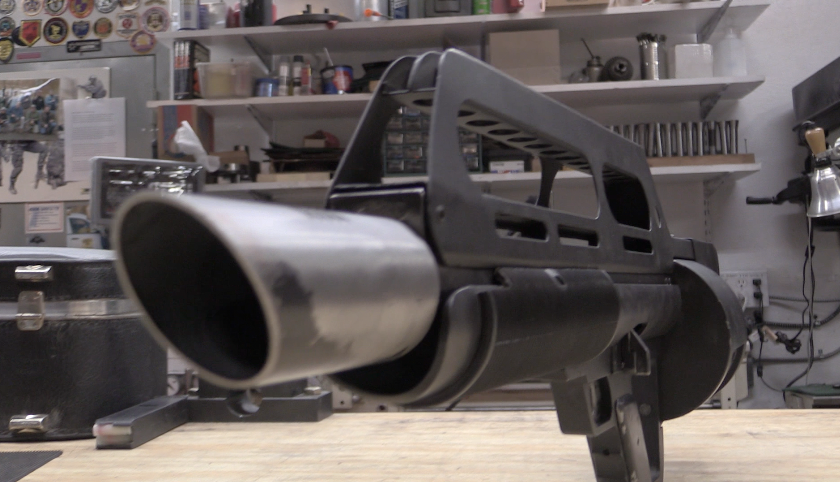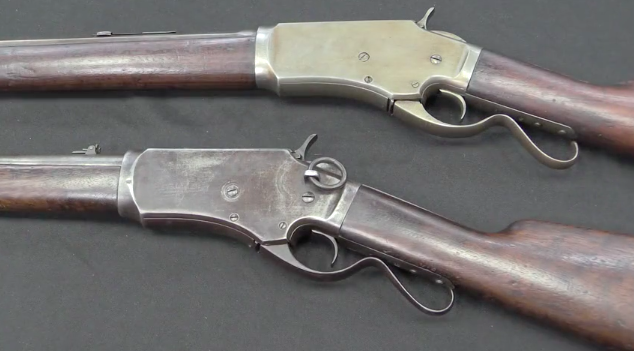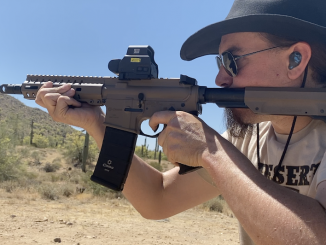David Wirth is one of the founders of Arcflash Labs, a small company developing “ultra-high energy pulsed power supplies”, which have applications in a variety of fields – but today we are talking about electromagnetic weaponry. Arcflash is currently shipping out their first batch of commercial GR-1 “Anvil” shoulder-fired gauss rifles. They brought one down for me to try out, and I figured it would be best to start with some background discussion. So today, David and I are talking about how coil guns and rail guns work (and what the difference between the two is), how Arcflash came about developing the GR-1, where they expect the technology to go, and the applications for this and future mass accelerators.
(For the record, I love being able to write a description like this and legitimately use terms like “rail gun” and “gauss rifle”…)
So, check it out! And stick around for a detailed look at the GR-1 Anvil on Friday, and the lunacy of me taking it to a Backup Gun Match on Saturday…




It’s nice to see someone willing to work on the bleeding edge of what they see as the future. I wonder if you could apply different spin to arc over barricades or hills?
I would say that the analogy with the Wright brothers is hardly appropriate.
After 12 years of development, there were already bombers, fighters, hydroplanes, aircraft carriers and who knows what else.
Rather, it is similar to controlled thermonuclear fusion. 😉
Good luck, guys.
You will need it.
Exactly, except “12 years” is generous. Every component of this has been maturing and developing for over 100 (including capacitors, which are everywhere), and EM guns themselves have been lavishly researched for at least 50.
Contrary to the video, the comparison to combustion guns is perfectly fair. Nobody would celebrate the Wright Flyer today if it had been built to compete with a different but mature, affordable, and highly effective airplane technology.
The airship?
In 1903 the airship didn’t really exist, let alone “mature, affordable, and highly effective”. After the necessary technologies (ICE and control surfaces) were proven by the Wrights, it became popular(ish) – until the Hindenburg crashed, proving that the common and affordable lifting gas wasn’t worth the risk of floating around below a giant thermobaric.
Airships haven’t really become “mature, affordable, and highly effective” even in 2022 – certainly not in any way comparable to the ubiquity of modern small arms.
Hydrogen was the culprit. GOODYEAR shows us everyday “driveable” is a safe way to travel. Slow but VERY safe. No accident like Zeppelin since the first GOODYEAR blimp.
Not “driveable”.
My stupid dumb idiotic imbecile DEMON RAT programmed phone cannot know what I say in other languages.
The word in French is “driveable” for blimp.
Stephane,
Hydrogen is dangerous, but helium is rare and more expensive (and heavier / less efficient, requiring a larger volume at that higher price). The failure of cheap and universally available hydrogen limited the airship to the small niche market it has been ever since.
That’s beside my point, though, which was not to condemn the airship but to refute the suggestion that the Wright Brothers had competition from an industry as universally established and accepted as gunpowder firearms are today.
“(…)The word in French is “driveable” for blimp.(…)”
Do you mean actually dirigeable as pictured as here
https://polandballcomics.tumblr.com/post/151651344101/king-of-the-air-via-reddit
Does the BUG Match have a specific “non-firearm” category (presumably intended for cap and ball revolver) or will this just fall in the big and unwieldy category?
“Gauss Rifles”
Wait… if it is so named after unit then how to call classic, combustion-based weapons? Kilocalorie Rifles?
How does GR-1 compares ballistic-wise to Rigsby
https://augfc.tumblr.com/post/81758739038/v-rigsbys-coilgun-origin-united-states-of
?
A word of caution to Ian if you actually use this in a match.
The choice of outfit and especially headgear is of the utmost importance.
Thanks for warning, now I would not be confused if I will someone with such gun and wearing clothes akin to Stainless Steel Rat https://www.mycomicshop.com/search?TID=228791
you gotta start somewhere, that is amazing. im so glad i’ll be around to watch these things get developed rather than just them always being that way.
This is 2nd only to a Sterling SMG for Cosplay Open Carry.
The very idea, it may happen, has the right to life.
Confused by the way it is done.
If you sit under a tree with your mouth open and wait for an apple to fall there (wait for the rising capacitors to appear), someone will definitely come and pick this apple first.
The fact that it operates (right now) at low MV but can handle relatively large (over 50 gram) projectiles points in the direction of a launcher rather than a “gun”. As in, something like a grenade launcher.
Increase the “bore diameter” to around 3 cm and accept a MV of around 50 m/s, and you might not have an SF “gaussrifle”, but you would have a potentially useful tear gas launcher for police use.
In fact, mount it on a vehicle wired in to the electrical system, so that the transformers can recharge continuously as long as the motor’s running, and you have an automatic grenade “projector”.
Other than firing tear gas rounds, a “canister” round loaded with paintball-type dye marker “pellets” might come in handy, as well.
cheers
eon
Using CO2 to launch low-energy projectiles is easier and more efficient. Not to mention gunpowder.
The whole point of a coil gun is to obtain projectile speeds that are unattainable when using gas as a working fluid.
True, but CO2 tanks for what is basically a Plamya can get big and heavy, and limit the number of rounds you can launch. They also tend to cause a falloff in velocity as the tank empties.
I’m thinking more something that can be carried in a police version of an M997, as opposed to say an M1126. Enough power from the engine for shot-to-shot consistency in MV and less all-up weight to begin with.
Also, less volume devoted to the power system (engine + generator vs. CO2 tanks) means more for other things. Like ammunition.
cheers
eon
“…They also tend to cause a falloff in velocity as the tank empties…”(C)
You are confusing compressed air.
The CO2 in the tank is a liquid, and the saturation vapor pressure (and, as a result, the performance) does not depend on the amount of liquid in the tank.
So you have electric outlet and need to launch grenades? Then maybe use centrifugal launcher, for example see photos https://raigap.livejournal.com/132955.html
The “centrifugal gun/launcher” is one of those perennials that is even older than the electromagnetic projector. Every effort to make one work has failed.
Manually cranked ones fail because, as was remarked by one expert when such a device was proposed for the British Army in WW1, leaving aside all considerations of friction, it would have taken roughly sixty hours of “cranking” by a soldier to build up enough KE to “fire” one round.
Electric and even IC engine powered ones fail because the centrifuge acts as a large gyroscope. Making it virtually impossible to “deflect” the mechanism in any direction. In short, once it is rotating fast enough to launch a projectile, you are “firing” on a fixed azimuth and elevation.
The “centrifugal gun” is one of those precious theories that is effectively murdered by the actual laws of physics. Right up there with perpetual motion.
cheers
eon
If they put on a bayonet lug it will be perfect!
Stephanie – The term I think you are looking for is “Dirigible” from the Latin “Dirigo” meaning to direct or steer (The French system of centralized government instituted by Colbert is known as “dirigisme”) – hence it is a “steerable balloon”
“(…)“Dirigible”(…)”?
Now I am extremely confused,it is not dirigeable (with a) https://fr.wikipedia.org/wiki/Ballon_dirigeable ?
“(…)to direct or steer(…)”
In early 20th there was Der Luftpirat und sein lenkbares Luftschiff series published in Germany, some books are available at Project Gutenberg, for example https://www.gutenberg.org/ebooks/56064
Note lenkbares which is adjective which might be translated as “able to turn”.
In English, “dirigible” has two meanings. One is a powered lighter-than-air vehicle with or without a structural frame inside its envelope.
However, the preferred terms are “rigid airship” for one with a fully-encompassing frame, such as a Zeppelin or Schutte-Lanz type, “semi-rigid” for one with a single keel structure but exposed gasbag (see “Roma” and “Italia”, plus “General Umberto Nobile”), and “blimp” for one having no rigid bracing structure at all, and either a single pressure “gasbag” or a set of several inside a non-braced outer envelope.
The other meaning is simply that if something is “dirigible”, it is steerable. The term shows up in science fiction from before World War Two, in reference to “dirigible torpedoes”, which we would call RPV type guided missiles today.
The term is often found in the works of E.E. “Doc” Smith, notably his Lensman novels.
cheers
eon
Dunno, I wish them luck, but I can remember reading about how controlled nuclear fusion was right around the corner. That was in “My Weekly Reader” in about 1962 or so when I was in Fourth Grade
“(…)how controlled nuclear fusion was right around the corner(…)”
I do not know about but it seems that periodically appearing “around the corner” idea is (affordable) flying automobile. Some better https://en.wikipedia.org/wiki/Convair_Model_118 or worse https://en.wikipedia.org/wiki/Henry_Smolinski working prototypes were made, but no mass production commence.
Daweo, Imagine 200 or so barely trained people aloft over Chicago in their aircars during a January snowstorm. I not sure who coined the phrase, but “Good Idea Faerie” comes to mind.
Wow, reference to Doc Smith! I salute you, sir!
“The pilot, who escaped with minor injuries, reportedly took off with little or no aviation fuel aboard. Although the fuel gauge he had visually checked during the pre-flight check indicated that the tank was full, it was the automobile’s fuel gauge, not the aircraft’s gauge”
‘Nuff said
I’ll shut up